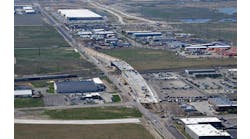By David Hamlet and Nathaniel Kirchner, Contributing Authors
In York County, Pennsylvania, near the state’s border with Maryland, Interstate-83 interchange at Exit 4 links to State Route 851. The interchange was outdated and not meeting traffic and safety demands.
Dubbed the “Gateway to Pennsylvania,” this $31 million project rehabilitated the connections with a diverging diamond interchange (DDI). The DDI not only enhanced safety and traffic flow, but also embraced environmental stewardship and community aesthetics.
The interchange is one of only three DDIs currently built in the commonwealth. Its design achieved project goals initially set by the Pennsylvania Department of Transportation (PennDOT). It reduced congestion and lowered crash rates.
A conscientious approach to the design of the facility was taken to enhance public safety and mobility.
Successfully addressing the various project challenges required collaborating with a diverse team of consultants, contractors, and stakeholders. This team included Wallace Montgomery, Susquehanna Civil, Merit Marketing, Whitman, Requardt & Associates, Kinsley Construction, Erdman Anthony, and local municipalities.
The I-83 interchange at Exit 4 presented countless challenges that required innovative solutions. Its confined footprint restricted conventional expansion.
The introduction of the DDI configuration allowed for direct left turns from off-ramps onto SR 851 and from SR 851 to on-ramps onto I-83, eliminating backups. Direct left turns also lowered the number of intersection conflict points from 26 in a traditional diamond configuration to 14, which is expected to reduce the crash rate by more than 40%.
The DDI has two phases per traffic signal cycle instead of three. This allows more green time per cycle than a standard diamond interchange configuration, which also improves traffic flow.
The design successfully integrates the challenges of various disciplines, from drainage and stormwater management to traffic analysis and construction services.
Navigating through a narrow transit corridor, the team balanced progress and preservation. One concern for project design and construction was preserving local watersheds that are vital to the region.
An innovative stormwater management system safeguarded the Deer Creek Watershed, deploying lined basins and specialized valves to shield against potential roadway spillage.
Additionally, a culvert replacement adjacent to environmentally sensitive lands proved critical. The culvert emphasized a commitment to sustainable solutions. The box culvert was 12-feet by 11-feet. It was an infrastructure upgrade that doubled as an opportunity to restore the stream’s natural flow and vitality. Its increased dimensions and design, which was conducive to the use of natural streambed material, revitalized the watercourse, breathing new life into the ecosystem.
The project stakeholders sought to preserve biodiversity, and the critically endangered bog turtle became a focal point. A specialized team surveyed the area and provided guidance on the project design to avoid impacts to the turtle’s habitat. Fencing acted as a barrier, shielding both the turtles and the wetlands from inadvertent disturbance during construction.
Engineering Excellence
The Exit 4 redesign ensured that every curve and intersection enhanced safety. Curve radii of 150 to 300 feet were used for crossover alignments to facilitate safe traffic flow through the DDI. An intersection crossover angle of 45 degrees also reduced potential incidents of “wrong way” driving.
Pavement markings and signage clearly assist motorists in navigating the interchange. The redesigned interchange accommodates pedestrians and bicyclists, unlike the previous interchange design.
To meet project needs, the team forecasted traffic demands decades into the future. The project design will accommodate increasing traffic volumes through the year 2060, 10 years beyond what simply expanding the tight diamond interchange would provide.
The DDI configuration also offers greater opportunity for future expansion than the tight diamond interchange option if growth exceeds projections. This forward-thinking approach led to a design that not only resolved present congestion but also accommodates anticipated growth, ensuring the interchange’s functionality for decades beyond its inception.
The challenges of balancing the competing needs of diverse stakeholders were met with the thoughtful design of all project elements with a dedication to safety and efficiency. Notably, this forward-thinking design accommodated pedestrians and cyclists — a testament to inclusive infrastructure planning.
Community Engagement
The need to integrate aesthetics into infrastructure projects is often overlooked. However, this interchange’s transformation served as a testament to the presence of art within architecture.
Special attention was given to landscaping and aesthetics. The aesthetics featured colonial-era dry stack stone retaining walls, seasonal plant beds, a flagpole with illuminated American and Pennsylvania flags, and artistic elements on bridge abutments, which depicted the Liberty Bell next to the quote “Life, Liberty, and the Pursuit of Happiness” — fitting for the “Gateway to Pennsylvania.”
The team led an extensive public outreach campaign, including establishing a project advisory group, holding a public meeting, and developing informational materials and a video illustrating how a DDI works, with the goal of obtaining acceptance of the overall design.
The team coordinated landscaping and aesthetic treatments with three local municipalities and four civic organizations to provide an access point to local communities.
The local fire station provided input for including a 10-foot gap in the pier under the bridge for improved emergency access. Several community organizations raised funds to purchase the flagpole, American flag, and sign for the intersection’s southeast quadrant.
The municipalities and civic organizations agreed to perpetually maintain the walls, shrubs, flagpole, and sign. The collaboration between firms, the client, and the surrounding community is a testament to the pride that the citizens of southern York County feel towards their home, and the desire to preserve its quality.
A Symbol for York County
I-83 Exit 4 is a vital interchange connecting the communities of southern York County to the greater region, while simultaneously facilitating travel with reduced traffic congestion.
The team’s role in the project’s design and construction required innovative planning, including a unique DDI design in a challenging environment, while protecting the well-being of local watersheds and ecosystems.
Exit 4 now provides improved safety, mobility, and aesthetics to regional and interstate travelers and is a source of community pride for this Gateway to Pennsylvania.
The project has garnered industry recognition, winning several awards, including the American Society of Highway Engineers (ASHE) Northeast Region 2023 Project of the Year, ASHE Harrisburg 2022 Project of the Year, American Council of Engineering Companies (ACEC) of Pennsylvania 2022 Diamond Award, and the ACEC 2022 National Recognition Award.
The project impact extends far beyond just asphalt and steel. It’s a catalyst for community. As commuters drive through Exit 4, they're traversing a symbol of community resilience, vision, and unity. Exit 4 stands tall, not merely as an interchange but as a testament to what can be achieved when engineering talent converges with community spirit to illuminate the identity of southern York County. RB
David Hamlet, P.E., is a vice president at Gannett Fleming. Nathaniel Kirchner, P.E., is a project manager at Gannett Fleming.



